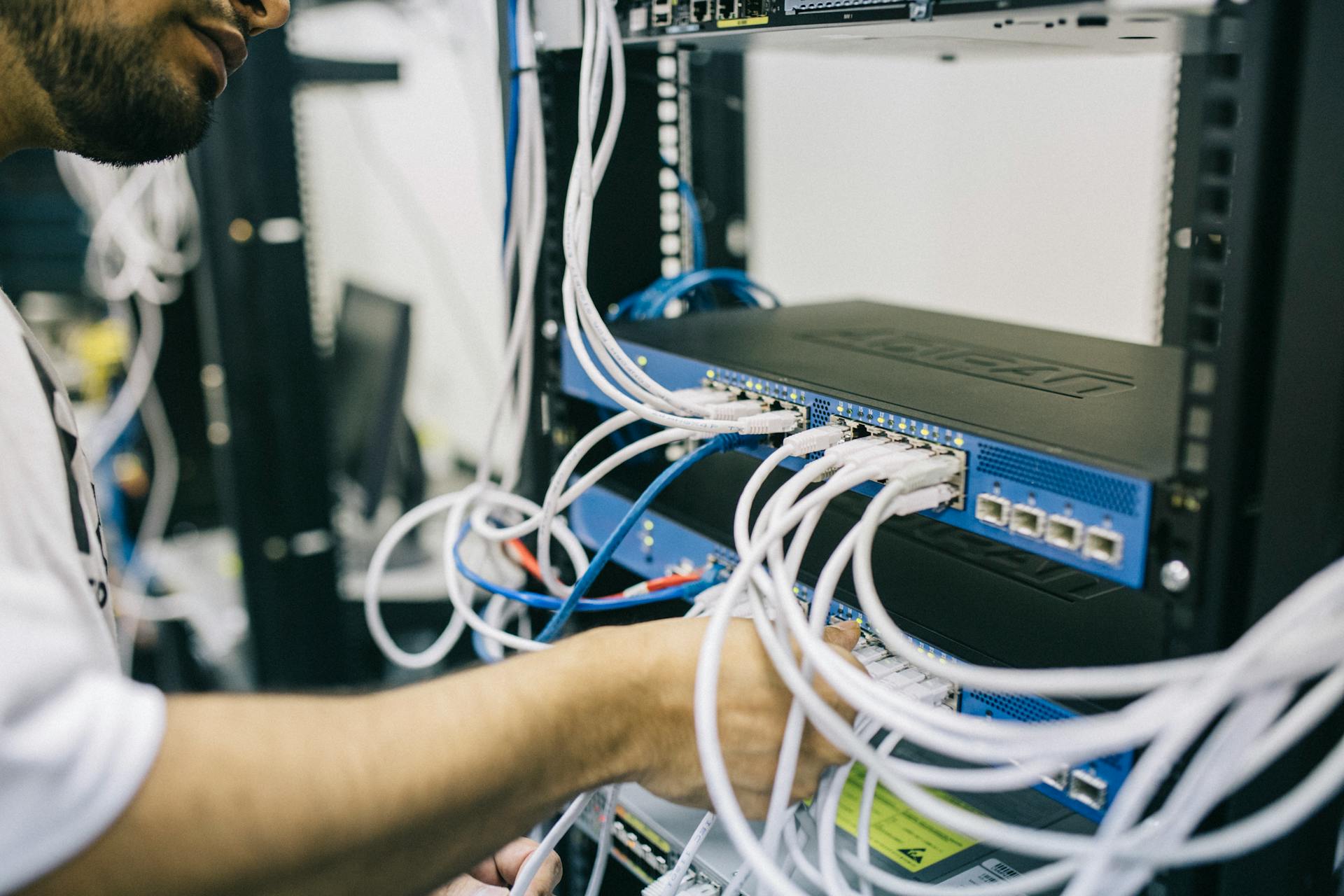
Implementing a HIPAA compliant firewall is a critical step in protecting sensitive patient data. This requires a deep understanding of the regulations and best practices for healthcare IT.
To ensure compliance, healthcare organizations must segment their network to limit access to sensitive areas. This can be achieved by creating separate virtual local area networks (VLANs) for different departments.
Regularly reviewing and updating your firewall rules is essential to prevent unauthorized access. This should be done at least annually, or whenever there are changes to your network or systems.
Firewall logs should be monitored regularly to detect any suspicious activity. This can help identify potential security breaches before they become major issues.
Basics
A HIPAA compliant firewall is a must-have for healthcare organizations, as it's required by law to protect sensitive patient information.
HIPAA (Health Insurance Portability and Accountability Act) regulations dictate that firewalls must be configured to prevent unauthorized access to electronic protected health information (ePHI).
The firewall must be able to block all incoming traffic by default, unless specifically allowed by a rule.
In the context of HIPAA, a firewall is considered a security measure that must be implemented at the perimeter of the network.
HIPAA compliant firewalls must be able to identify and block malicious traffic, including malware and phishing attacks.
The firewall must be configured to allow only necessary traffic to access the network, and to block all other traffic.
Regular audits and risk assessments are required to ensure the firewall is functioning correctly and meeting HIPAA compliance requirements.
Related reading: Hipaa Firewall Requirements
Firewall Configuration
Firewall Configuration is a critical aspect of maintaining a HIPAA compliant firewall. To configure your firewall properly, you need to set up inbound and outbound rules that balance security with business needs.
If there's no strong business justification for allowing connections from outside, the most secure option is to turn off all remote access. But, if you need to use remote access, you'll need to set up a VPN, which requires a username, password, and secret code unique to the remote computer.
To manage outbound firewall rules, think about the different roles or job functions that computers are used for. For example, receptionists may need to access company email and websites, but not social media or personal email accounts. You can whitelist these computers to only allow access to specific websites.
Here's a simple way to think about it: RoleAllowed WebsitesReceptionistCompany email, company websiteEMR SystemNone (block all Internet access)
Accurate network and PHI flow diagrams are also essential for firewall documentation. These diagrams show how your systems interact with patient data and help you identify which systems need to be secured and separated from others.
Consider reading: Microsoft 365 Hipaa Compliant Email
Outbound Rules
Outbound rules are just as important as inbound rules when it comes to configuring your firewall.
Allowing your computers to access the Internet can increase the chances of malicious software infection. You can prevent this by blocking computers from having any access to the Internet if they don't need it.
A fresh viewpoint: Hipaa Access Control
Consider the different roles or job functions that computers are used for, such as receptionists who need to access company email and websites. They probably don't need access to social media or personal email.
You can whitelist these computers so that employees can only go to the websites you want them to go to. This will help keep your network secure and prevent unauthorized access.
Blocking computers from the Internet is especially important for systems that store, process, or transmit sensitive information like electronic medical records.
Broaden your view: Hipaa Secure Email
Network and Flow Diagrams
Accurate PHI flow diagrams are vital for firewall documentation. They show how your systems are interacting with patient data.
Systems that store, process, or transmit PHI data need to be properly secured and separated from other systems on your network. This means creating a diagram that shows how PHI enters your network, the systems it touches as it flows through your network, and any point it may leave your network.
Explore further: Hipaa Compliant Computer Disposal
For example, patients may fill out forms at hospitals, which pass patient records to doctors' offices, which then transfer medical records to pharmacies. You can also include online patient portals where patients add sensitive information, which is then emailed to a dentist receptionist who prints and stores it in a file cabinet.
To create a comprehensive diagram, you'll need to examine your actual network and decide how it fits into your PHI flow diagram. Ask yourself questions like: How is my network constructed? Is there one firewall at the edge of networks with PHI access?
Here are some key questions to consider when evaluating your network:
- How is my network constructed?
- Is there one firewall at the edge of networks with PHI access?
- Is my network segmented internally?
- Does my environment have a multi-interface firewall?
- Do I have multiple firewalls?
Once you have a clear understanding of your network and PHI flow diagram, you can make necessary adjustments to your firewall rules to ensure your organization's firewall(s) are properly set up.
Nat
NAT is a fundamental concept in IT architecture design, providing a layer of security and flexibility in hosting options.
IT Architecture Design, Security, & Guidance is where NAT plays a crucial role, allowing for flexible private, public, and hybrid hosting solutions.
Key Features of NAT include its ability to provide secure and flexible hosting options.
Recommended read: Hipaa Compliant Cloud Server
Test and Monitor
Network firewalls aren't a plug-and-forget technology, and it's essential to regularly test and monitor them to ensure there are no security weaknesses. This means revising firewall rules at least every six months.
Firewall rules need to be revised regularly to account for changes in your environment. This will help you stay ahead of potential security threats.
Testing the effectiveness of your firewall rules is crucial to identifying vulnerabilities. You should scan for rogue wireless access points, especially if they're attached to your non-guest network.
Regular vulnerability scans can provide valuable insight into your network security. This can be done weekly, monthly, or quarterly.
Penetration tests are a more thorough way to examine network security. They can help you identify weaknesses that may have been missed by vulnerability scans.
Log Management and Compliance
Log management plays a vital role in monitoring firewalls and ensuring HIPAA compliance. It helps prevent, detect, and minimize the impact of a data breach by tracking normal and potentially damaging user actions.
To take advantage of log management, organizations should decide how and when to generate logs, secure stored logs, and assign an employee to review logs daily. They should also set up a team to review suspicious alerts and spend time creating rules for alert generation.
Here are the essential steps for log management:
- Decide how and when to generate logs
- Secure stored logs
- Assign an employee to review logs daily
- Set up a team to review suspicious alerts
- Create rules for alert generation
- Store logs for at least six years
- Frequently check log collection to identify necessary adjustments
Vulnerability Scan
A vulnerability scan is an automated test that looks for potential vulnerabilities in your system. It's a crucial step in ensuring the security of your data, especially when dealing with sensitive information like PHI.
You should scan all external IPs and domains with PHI access at least quarterly. This is a best practice recommended by almost every security expert.
A vulnerability scan typically generates a list of vulnerabilities found, along with references for further research and sometimes even directions on how to fix the problem. This report can be extensive, so be prepared to take action.
Act quickly on any vulnerabilities discovered, and then re-scan to validate that the vulnerabilities have been successfully addressed. Scanning is not enough - you need to take action to patch security holes.
To ensure the security of your data, consider implementing the following measures:
- Install a firewall between wireless networks and networks with PHI access (wireless only)
- Install a web application firewall on public-facing applications
Log Management
Log management is a crucial aspect of maintaining a secure and compliant environment. It involves setting up logging to generate real-time alerts and backtracking to discover what occurred during a problem. Logs keep track of both normal and potentially damaging user actions happening against a firewall and help prevent, detect, and minimize the impact of a data breach.
To take advantage of log management, you need to decide how and when to generate logs, secure your stored logs, and assign an employee to review logs daily. You should also set up a team to review suspicious alerts and spend time to create rules for alert generation. It's essential to store logs for at least six years and frequently check log collection to identify necessary adjustments.
Organizations should review their logs daily to search for errors, anomalies, or suspicious activity that deviate from what's normal. This is because nearly all firewalls have very limited logging space, and it's essential to set up a logging server to monitor logs from the firewall and other systems.
Here are the key steps to implement effective log management:
- Decide how and when to generate logs
- Secure your stored logs
- Assign an employee to review logs daily
- Set up a team to review suspicious alerts
- Spend time to create rules for alert generation
- Store logs for at least six years
- Frequently check log collection to identify necessary adjustments
By following these steps, you can ensure that your log management system is effective in detecting and preventing data breaches.
Tasks to Complete
To stay on top of log management and compliance, you'll want to complete the following tasks:
Review logs and security events daily to catch any anomalies or exceptions that may arise.
Document all firewall policies and procedures to ensure you can quickly reference them in case of an audit.
Keep all audit log records for at least one year and have the last three months' logs readily available for analysis.
Run internal vulnerability scans on a quarterly basis using a qualified resource or third party to identify and resolve high-risk vulnerabilities.
Create a process to respond to any anomalies or exceptions that are discovered during log reviews.
Implement a firewall to prohibit direct inbound and outbound traffic from networks with PHI traffic.
Position a secure zone for any networks with PHI access, separate from the DMZ.
Here's a quick reference list of tasks to complete:
- Review logs and security events daily
- Document firewall policies and procedures
- Keep audit log records for at least one year
- Run quarterly internal vulnerability scans
- Respond to anomalies or exceptions
- Implement a firewall for PHI networks
- Position a secure zone for PHI networks
- Run quarterly external vulnerability scans
- Run wireless scanning at least quarterly
Compliance and Security
Having a HIPAA compliant firewall is crucial for protecting sensitive patient data. A firewall's goal is to filter potentially harmful Internet traffic from the Internet to protect valuable protected health information (PHI).
To become HIPAA compliant, you must ensure your firewall is properly configured. According to recent breaches analyzed by SecurityMetrics' team of forensic investigators, 76% of investigated organizations had incorrectly configured firewalls.
Here are five basic firewall configuration best practices to follow:
- Set security settings for each switch port, particularly if using segmentation.
- Update firewall rules if your applications and/or systems don’t have proper security hardening in place (e.g., out-of-date software, default accounts and passwords).
- Set up virtual private networks (VPNs) if using remote access.
- Decide what traffic comes in and out of your network.
- Segment different networks with switch ports (e.g., Internet, office, EMR).
Introduction
Compliance and security go hand in hand, especially when it comes to protecting sensitive data. A network firewall is a crucial component in achieving HIPAA compliance, as it filters out potentially harmful internet traffic to safeguard protected health information (PHI).
For more insights, see: What Is Hipaa Compliance
Installing a firewall is just the first step, though. It's a common misconception that having a firewall in place automatically makes you HIPAA compliant. Firewalls can be riddled with configuration flaws, leaving your systems vulnerable to breaches.
Recent breaches have shown that 76% of investigated organizations had incorrectly configured firewalls, highlighting the need for proper implementation and maintenance.
Best Practices
Firewalls are a crucial part of any network's security, and following best practices can make all the difference. To ensure your firewall is configured correctly, start by setting security settings for each switch port, particularly if you're using segmentation.
Having strict firewall rules is essential to prevent unauthorized access to your network. This means updating your firewall rules if your applications and/or systems don't have proper security hardening in place, such as out-of-date software or default accounts and passwords.
If you're using remote access, set up virtual private networks (VPNs) to add an extra layer of security. Decide what traffic comes in and out of your network by establishing inbound and outbound rules.
Segmenting different networks with switch ports is also a good idea, for example, separating your Internet, office, and EMR networks. This can help prevent data breaches and protect sensitive information.
Firewalls should be reviewed frequently to ensure they're working correctly and securely. This means reviewing your firewall rules and configuration, and making adjustments as necessary.
Here are some key best practices to keep in mind:
- Write strict firewall rules.
- Pay attention to what logs tell you.
- Review firewall configurations frequently, adjust as necessary, and document everything.
By following these best practices, you can help ensure your firewall is configured correctly and securely, and that your network is protected from unauthorized access.
Maintaining Compliance with Cloud Providers
Cloud computing can be a game-changer for healthcare organizations, but it's not a silver bullet when it comes to HIPAA compliance. You, as the covered entity, have responsibilities to maintain compliance when using cloud computing.
Cloud providers can't guarantee HIPAA compliance on their own, so you need to ensure they're configured correctly to protect ePHI. This means using tools to ensure compliance and following up with monitoring and reporting.
Intriguing read: Hipaa Compliance Plan
The healthcare organization must take the lead in ensuring HIPAA compliance with cloud providers, while the CSP must provide secure infrastructure and tools for compliance. No official HIPAA certifications exist for cloud services, so it's up to both parties to adhere to HIPAA's requirements.
To maintain compliance with cloud providers, follow these best practices:
- Ensure the CSP provides secure infrastructure and tools for compliance.
- Use tools to ensure compliance and follow up with monitoring and reporting.
- Review and update firewall rules regularly to ensure they're aligned with your organization's security needs.
Remember, maintaining compliance with cloud providers requires ongoing effort and attention to detail. By following these best practices, you can ensure your cloud computing setup is secure and HIPAA-compliant.
Broaden your view: Hipaa Compliant Cloud Storage
Intrusion Prevention Service
Our Intrusion Prevention Service is a game-changer for businesses that need robust security without breaking the bank. It works off a continually-revised database of malware and other potential hazards.
This service features customizable security infrastructure that can be tailored to your specific needs. It's like having a personalized security plan that adapts to your unique requirements.
We regularly test and re-test all components of IPS to ensure it's always up-to-date and effective. This means you can trust that your security is being monitored and upgraded on an as-needed basis.
A fresh viewpoint: Hipaa Compliant Answering Services
A powerful Firewall Appliance is also included, which connects to each interface to monitor everything from CPU usage to response rate for gateways. This gives you a clear picture of your network's performance.
Traffic shaping and simultaneous connection limitations are easily configurable, so you can fine-tune your security to suit your needs. This is especially useful for businesses with complex networks.
All of this is available at a cost-effective price, which is much lower than hiring your own cyber security staff. This makes our Intrusion Prevention Service an attractive option for businesses that need world-class security without the hefty price tag.
Frequently Asked Questions
What firewalls are HIPAA compliant?
For HIPAA compliance, consider firewalls from reputable vendors like Cisco ASA with FirePOWER, Fortinet FortiGate, WatchGuard Firebox, Sophos XG Firewall, and ZyXEL ZyWALL, which offer robust security features and auditing capabilities. These firewalls help protect sensitive healthcare data from cyber threats and ensure compliance with HIPAA regulations.
Do you need a VPN to be HIPAA compliant?
No, HIPAA regulations do not require the use of a VPN, but it is recommended for covered entities and business associates to consider using one for added security.
Sources
- https://www.securitymetrics.com/learn/how-to-implement-and-maintain-hipaa-compliant-firewalls
- https://cloudsecurityalliance.org/blog/2023/05/11/8-things-healthcare-organizations-can-do-to-ensure-hipaa-compliance-in-the-cloud
- https://www.atlantic.net/hipaa-compliant-hosting/hipaa-compliant-security/
- https://www.securitymetrics.com/blog/how-to-implement-and-maintain-hippa-compliant-firewalls
- https://blocksurvey.io/hipaa-compliant-tools/hipaa-compliant-firewalls
Featured Images: pexels.com


